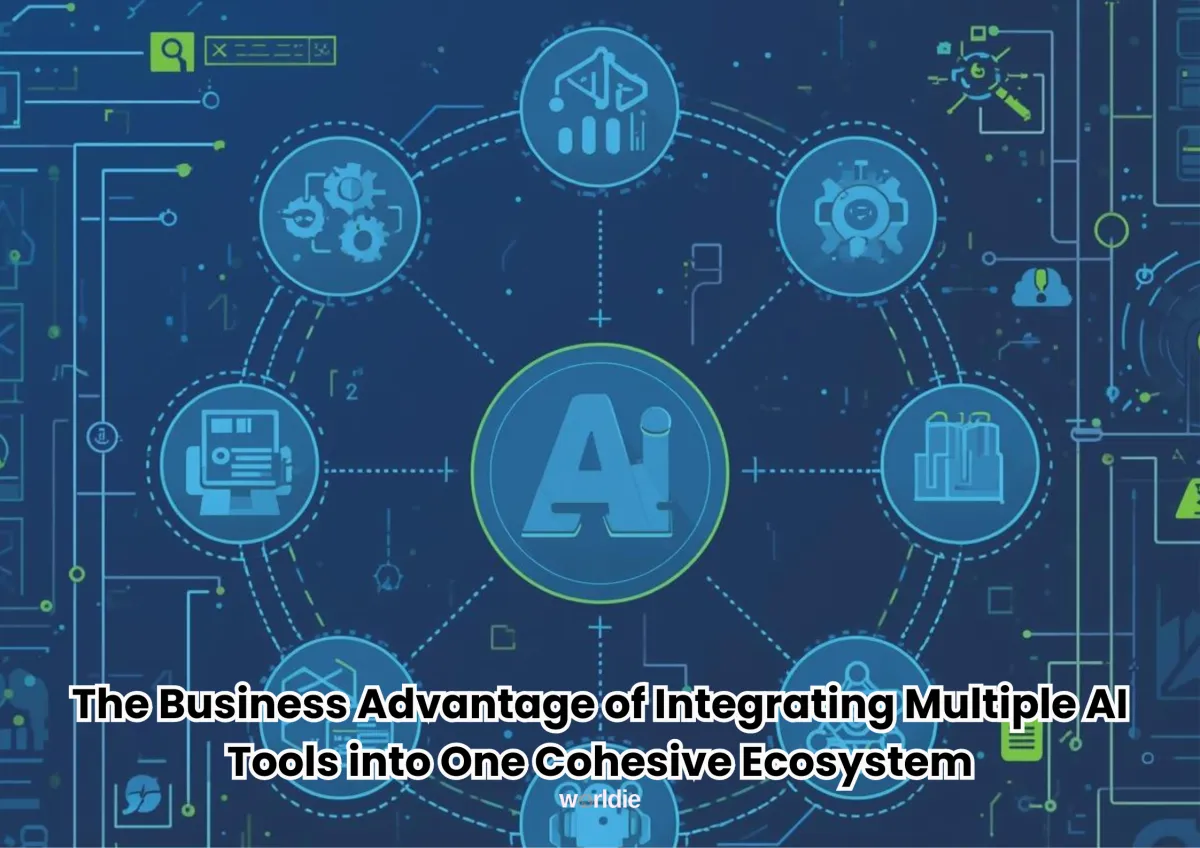
The Business Advantage of Integrating Multiple AI Tools into One Cohesive Ecosystem
Integrating multiple AI tools into one cohesive ecosystem is rapidly becoming the strategic cornerstone of digital transformation. Businesses have spent years experimenting with artificial intelligence—chatbots here, analytics dashboards there—but few have achieved the kind of synchronized intelligence that actually transforms performance. The difference between scattered adoption and cohesive integration defines whether AI becomes a cost center or a profit accelerator.
When AI systems are built to operate together—sharing data, learning from one another, and automating workflows across departments—they form a unified digital ecosystem capable of adapting in real time. Worldie AI specializes in designing and implementing these ecosystems, transforming fragmented technologies into revenue-generating intelligence layers that evolve with the business.
Understanding What It Means to Integrate Multiple AI Tools
Integrating multiple AI tools into one cohesive ecosystem goes far beyond connecting APIs or merging dashboards. It means building an intelligent infrastructure where every model, algorithm, and data stream serves a shared objective. Machine learning systems trained for prediction communicate seamlessly with natural language models built for interaction. Automation platforms trigger analytics workflows automatically. Insights flow continuously between sales, marketing, operations, and finance.
The result is an organization that doesn’t just collect data—it interprets it, learns from it, and acts on it faster than the competition. This level of cohesion is what separates true AI-driven enterprises from those simply experimenting with automation.
Why Fragmented AI Efforts Limit Growth
Many businesses invest heavily in artificial intelligence but fail to generate consistent returns because their tools operate in isolation. Marketing departments might use predictive algorithms to segment audiences, while customer service teams rely on chatbots trained on entirely separate datasets. Finance might automate forecasting without visibility into operational data.
The challenge isn’t the sophistication of each tool—it’s the lack of integration. Without shared intelligence, each department becomes its own island, producing valuable insights that never reach the rest of the organization. This fragmentation leads to inefficiencies, duplicated costs, and inconsistent decision-making. Integration turns those isolated efforts into a powerful, interconnected system that compounds value across every business function.
The Hidden Cost of Siloed AI Systems
Disjointed AI systems create friction that slows progress. Data scientists spend time reconciling inconsistent information instead of training models. Operations teams struggle to interpret analytics that are disconnected from customer behavior. Strategic decisions are made with incomplete insights.
Beyond inefficiency, siloed systems limit innovation. When insights aren’t shared, AI cannot recognize patterns that cross departmental boundaries—like how supply chain fluctuations might affect marketing outcomes or how customer sentiment impacts product performance. A cohesive ecosystem breaks these barriers, turning every data point into a contributor to collective intelligence.
Laying the Foundation: Unified AI Infrastructure
A successful AI ecosystem begins with a unified infrastructure—a single architecture where all tools can communicate through structured data flows. Every system, whether it’s a chatbot or a predictive model, connects to a central data layer that standardizes information and ensures consistency.
Worldie AI takes a methodical approach to this process using its Design → Build → Release framework. During the design phase, every business objective is translated into measurable AI goals. The build phase focuses on developing interoperable models and establishing automation pipelines that work across departments. Finally, the release phase deploys these systems in controlled environments with real-time performance monitoring, ensuring reliability before full-scale rollout.
This approach transforms AI from a set of independent projects into a scalable infrastructure—one that continuously evolves and adapts to market conditions.
Common Inefficiencies in AI Implementation
Many organizations underestimate the complexity of deploying multiple AI systems. Common inefficiencies include duplicated data collection, inconsistent performance monitoring, and manual workflows that interrupt automation. Teams often develop models without shared governance, resulting in varying standards of quality and ethics.
Worldie AI helps businesses overcome these inefficiencies by establishing centralized orchestration layers—intelligent systems that synchronize data pipelines, standardize decision protocols, and align every AI initiative with corporate strategy. This orchestration layer becomes the connective tissue that keeps the ecosystem coherent and adaptive.
Industry-Wide Applications of Integrated AI Ecosystems
In retail, AI integration allows recommendation engines, supply chain forecasting, and dynamic pricing systems to collaborate in real time. When a product trend spikes, the system automatically predicts demand, adjusts pricing, and triggers restock orders.
In healthcare, unified AI ecosystems combine diagnostic imaging analysis, patient history predictions, and hospital resource optimization into a single framework. This coordination not only enhances patient care but also minimizes operational waste.
In manufacturing, interconnected AI systems oversee quality assurance, maintenance scheduling, and supplier coordination—driving continuous improvement without manual oversight.
In finance, fraud detection, credit scoring, and customer analytics tools share data securely to increase accuracy and prevent false positives.
These examples illustrate one truth: the value of AI compounds exponentially when systems communicate rather than compete.
The Role of Data Architecture in Integration
Every AI ecosystem relies on data architecture as its foundation. Data must be clean, standardized, and accessible to every model in real time. Disparate datasets lead to inconsistent predictions and uncoordinated actions.
Worldie AI designs unified data frameworks that consolidate structured and unstructured data into centralized repositories. Through real-time synchronization and secure APIs, every AI system can draw from the same intelligence pool. This creates a living, breathing infrastructure that reflects current conditions across the entire organization.
Workflow Orchestration: The Silent Power Behind Integration
Workflow orchestration defines how each AI component interacts. It’s the invisible framework that triggers the right process at the right time. A predictive model identifying a high-value lead might automatically alert the CRM, trigger a customized email campaign, and update the customer profile for the analytics team—all without human intervention.
By orchestrating workflows, AI transitions from being a collection of smart tools to an automated intelligence engine that runs the business rhythmically and reliably. Worldie AI specializes in building these workflows with traceability and optimization at their core, ensuring each action can be monitored, refined, and scaled.
Human-AI Collaboration: The Intelligent Partnership
Integration doesn’t replace human expertise—it elevates it. While AI systems handle pattern recognition, data processing, and repetitive decisions, human insight remains critical for strategy, creativity, and ethics.
Worldie AI’s integrated systems are designed to support human-in-the-loop interactions, where feedback from employees continually improves model performance. This collaboration ensures that automation remains aligned with real-world objectives and that the workforce evolves alongside technology rather than being displaced by it.
The Worldie AI Design → Build → Release Framework
Worldie AI’s signature approach ensures that AI integration delivers tangible business outcomes. The Design phase identifies the core objectives and defines success metrics aligned with revenue, efficiency, and scalability. The Build phase develops the infrastructure—creating interoperable models, shared data environments, and automation frameworks. The Release phase deploys the ecosystem in live environments, where performance is monitored, refined, and expanded incrementally.
This disciplined framework reduces risk, improves adoption speed, and turns AI investment into measurable competitive advantage.
Challenges in Integrating AI Tools
Integration is not without obstacles. Data compatibility issues arise when legacy systems use formats that AI models can’t interpret. Security and compliance become complex when data flows across departments or borders. Training teams to use new technologies requires both time and cultural adjustment.
Worldie AI mitigates these challenges through standardized data governance, encryption, and access control protocols. Training programs and change management strategies help organizations adapt smoothly, ensuring that technology enhances rather than disrupts daily operations.
Measuring Success: Metrics That Matter
Success in AI integration isn’t measured by the number of models deployed—it’s measured by the value they generate. Leaders should assess improvements in decision speed, cost reduction, predictive accuracy, and automation coverage. When departments begin sharing real-time insights, when processes self-optimize, and when business decisions become consistently data-driven, the ROI becomes unmistakable.
Worldie AI provides real-time dashboards and analytics frameworks that translate AI performance into clear business metrics. Executives can visualize exactly how each component of the ecosystem contributes to revenue and efficiency.
Transformation in the Real World
A global logistics company once struggled with fluctuating delivery times due to poor communication between scheduling and route optimization systems. By integrating predictive models, IoT data, and real-time analytics into one AI ecosystem, they reduced delays by nearly a third while cutting fuel costs significantly.
A digital retailer faced similar fragmentation across marketing and supply chain systems. Worldie AI unified their AI stack, connecting recommendation engines, demand forecasting, and warehouse management. The result was higher conversion rates, better inventory control, and faster delivery cycles—all measurable within months of deployment.
These stories show that integration is not about adopting more tools—it’s about aligning existing ones to work as a single intelligent entity.
The Future of Integrated AI Ecosystems
The future belongs to organizations that treat AI as a continuous learning organism rather than a collection of static tools. Integrated ecosystems will evolve into self-managing networks capable of retraining models autonomously, identifying anomalies instantly, and deploying updates without manual oversight.
Worldie AI is advancing toward this future by developing adaptive systems that grow smarter with every transaction, every decision, and every customer interaction—turning business intelligence into living intelligence.
Governance, Transparency, and Ethical Integration
As AI systems expand in power and scope, governance becomes paramount. Every integrated system must comply with data privacy regulations, maintain ethical boundaries, and offer explainability for its decisions.
Worldie AI embeds transparency directly into its architecture. Each model’s logic is documented, each data source traceable, and every decision auditable. This ensures that AI ecosystems remain not only intelligent but also trustworthy.
Financial and Strategic Impact of Integration
When AI tools are integrated into a single ecosystem, financial impact follows naturally. Costs fall because redundant processes disappear. Revenue rises because decisions are faster, more accurate, and more consistent. Innovation accelerates because data becomes accessible to every department.
For many organizations, this transformation marks the shift from incremental automation to exponential intelligence—a system capable of learning across the entire business, not just within one function.
Strategic Takeaways for Decision Makers
For leaders, the goal is not to deploy more AI, but to unify it. Every investment should contribute to a shared intelligence framework. Data should be treated as a company-wide asset. Integration must be built into the architecture from the start, not retrofitted after deployment.
Worldie AI partners with organizations at every stage of this journey, ensuring that integration is not just a technical achievement but a strategic advantage—one that drives long-term scalability and measurable growth.
FAQs
1. How can a business begin integrating multiple AI tools without disrupting operations?
Start with an integration roadmap that identifies critical systems, defines clear objectives, and prioritizes data connectivity. Begin with low-risk integrations that deliver visible results, then expand gradually. This approach allows for adaptation without interrupting core workflows.
2. What types of AI tools work best in an integrated ecosystem?
Any combination of machine learning models, automation systems, and analytics platforms can be integrated. The key lies in interoperability—tools must communicate through APIs and shared data layers. Worldie AI customizes each stack to suit the business’s operational and financial goals.
3. How can executives measure the ROI of AI integration?
ROI should reflect tangible improvements such as reduced manual workload, faster decision cycles, higher customer retention, or measurable cost savings. Worldie AI provides real-time monitoring tools that translate performance into financial metrics for transparency and accountability.
4. What are the main risks of integrating multiple AI systems?
The biggest risks include data inconsistency, compliance breaches, and technical incompatibility. Proper governance frameworks, standardized data models, and continuous monitoring help mitigate these risks effectively.
5. How does Worldie AI ensure seamless collaboration across departments during integration?
Worldie AI builds ecosystems around a central orchestration layer that connects every tool, workflow, and analytics channel. This ensures that departments share insights instantly, eliminating redundancy and creating unified, intelligent decision-making across the organization.

